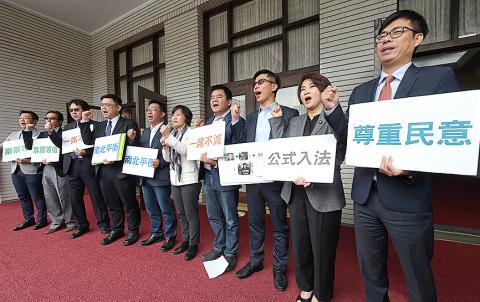The Central Election Committee’s planned adjustments to the allocation of legislative seats for the 2020 election would exacerbate the north-south divide and aggravate legislative malapportionment, Democratic Progressive Party (DPP) lawmakers told a news conference yesterday, saying constitutional reform is the sole solution.
The committee on Feb. 1 announced plans to assign one additional seat for both Tainan and Hsinchu County, while taking away one seat each from Kaohsiung and Pingtung County.
The north-south divide refers to the unequal pace of development between more urbanized northern Taiwan and the rural south, while the issue of malapportionment refers to the suspicion that a majority of electoral constituencies have been assigned to certain areas to protect some communities of interest, she said.

Photo: Chang Chia-ming, Taipei Times
The change would lead to fewer lawmakers representing Kaohsiung voters — eight lawmakers would represent 340,000 voters, instead of the current nine representing 300,000 voters — despite the city’s population not declining, she said.
A draft amendment to Article 4 of the Constitution has been cosigned by 35 lawmakers, DPP Legislator Liu Shih-fang (劉世芳) said, in which each of the 73 regional legislative seats would represent 300,000 voters, with an additional seat assigned for every 150,000 voters after that by taking one seat out of the legislator-at-large list, Liu said.
The amendment would maintain the current maximum of 113 legislative seats and would minimize the controversies caused by the two issues, she said.
DPP Legislator Chung Chia-pin (鍾佳濱) said total legislative seats is sure to decrease over the coming decade and constituencies should be drawn in proportion to area in addition to population.
Northern Taiwan has an area of 10,281km2 and a population of 9.71 million, while the south covers 25,000km2 and has 8.35 million people, and yet northern Taiwan is represented by 36 legislative seats, while southern Taiwan has 34, Chung added.
Legislative representation for Hsinchu County would be almost halved — from 550,000 per seat to 270,000 per seat — if the committee’s proposal is passed, DPP Legislator Lai Jui-lung (賴瑞隆) said, adding that compared with Lienchiang County, representing 120,000 voters per seat, it is evident that the system is problematic.
Lai called for the establishment of a more rational legislative seat apportionment via constitutional reform.
The committee’s baseless revision of electoral seats in Kaohsiung and Pingtung County would harm the concept of apportionment, DPP Legislator Chao Tien-lin (趙天麟) said, adding that he supports constitutional reform.
Apportionment is a core value of democracy and any issue guaranteed by the Constitution that is to be changed should only be changed through the Constitution, DPP Legislator Chen Chi-mai (陳其邁) said.
How legislative seats are defined, and by what equations, should be made clear and written into law, Chen said, adding that only then could anyone be satisfied that the rules are clear.
Results of the proposed changes, if tendered to the legislature’s Internal Administration Committee by May 31, would be announced by Jan. 31 next year and, if passed, used in the 2020 legislative election.

US climber Alex Honnold is to attempt to scale Taipei 101 without a rope and harness in a live Netflix special on Jan. 24, the streaming platform announced on Wednesday. Accounting for the time difference, the two-hour broadcast of Honnold’s climb, called Skyscraper Live, is to air on Jan. 23 in the US, Netflix said in a statement. Honnold, 40, was the first person ever to free solo climb the 900m El Capitan rock formation in Yosemite National Park — a feat that was recorded and later made into the 2018 documentary film Free Solo. Netflix previewed Skyscraper Live in October, after videos

Starting on Jan. 1, YouBike riders must have insurance to use the service, and a six-month trial of NT$5 coupons under certain conditions would be implemented to balance bike shortages, a joint statement from transportation departments across Taipei, New Taipei City and Taoyuan announced yesterday. The rental bike system operator said that coupons would be offered to riders to rent bikes from full stations, for riders who take out an electric-assisted bike from a full station, and for riders who return a bike to an empty station. All riders with YouBike accounts are automatically eligible for the program, and each membership account

NUMBERS IMBALANCE: More than 4 million Taiwanese have visited China this year, while only about half a million Chinese have visited here Beijing has yet to respond to Taiwan’s requests for negotiation over matters related to the recovery of cross-strait tourism, the Tourism Administration said yesterday. Taiwan’s tourism authority issued the statement after Chinese-language daily the China Times reported yesterday that the government’s policy of banning group tours to China does not stop Taiwanese from visiting the country. As of October, more than 4.2 million had traveled to China this year, exceeding last year. Beijing estimated the number of Taiwanese tourists in China could reach 4.5 million this year. By contrast, only 500,000 Chinese tourists are expected in Taiwan, the report said. The report

Temperatures are forecast to drop steadily as a continental cold air mass moves across Taiwan, with some areas also likely to see heavy rainfall, the Central Weather Administration (CWA) said. From today through early tomorrow, a cold air mass would keep temperatures low across central and northern Taiwan, and the eastern half of Taiwan proper, with isolated brief showers forecast along Keelung’s north coast, Taipei and New Taipei City’s mountainous areas and eastern Taiwan, it said. Lows of 11°C to 15°C are forecast in central and northern Taiwan, Yilan County, and the outlying Kinmen and Lienchiang (Matsu) counties, and 14°C to 17°C